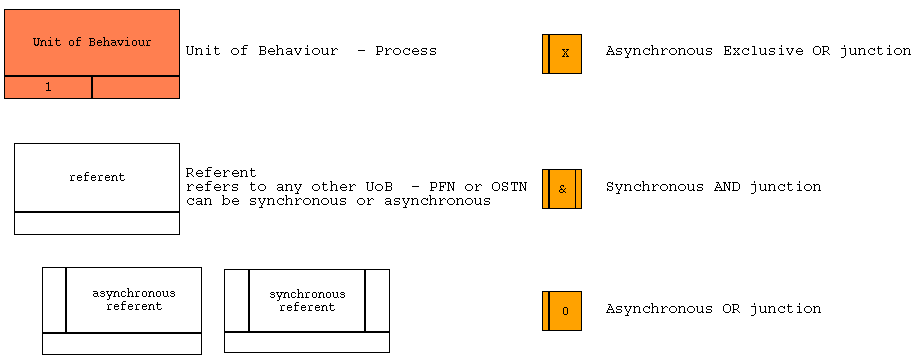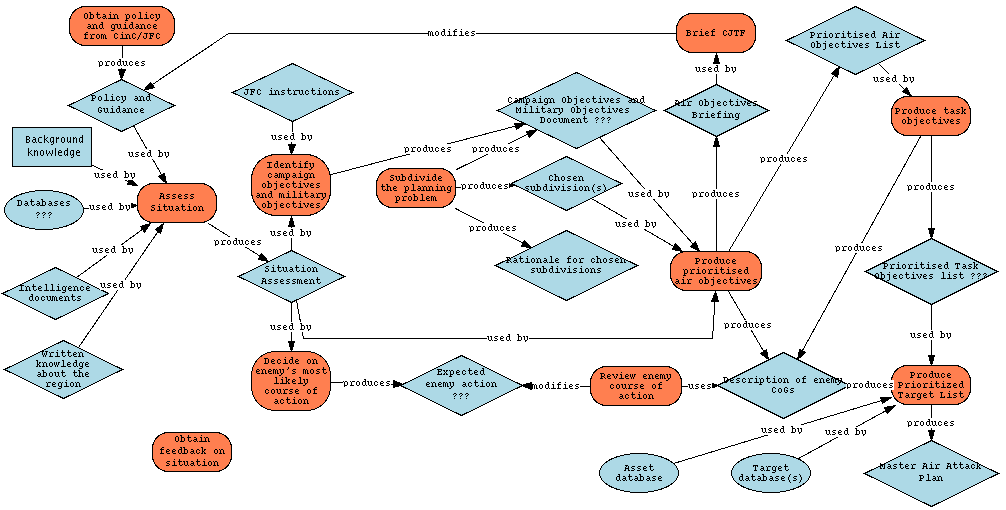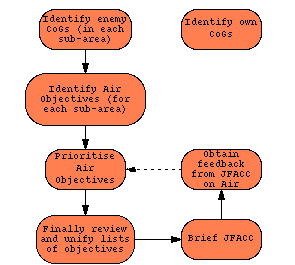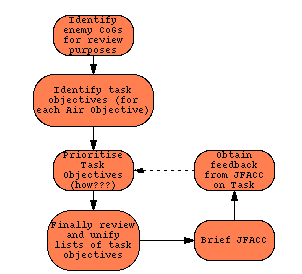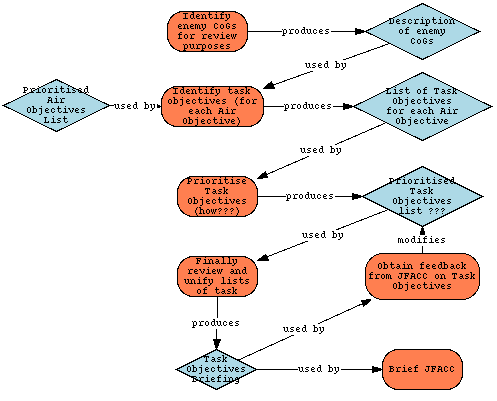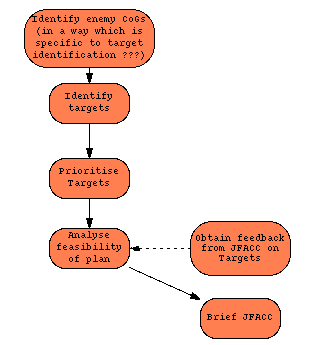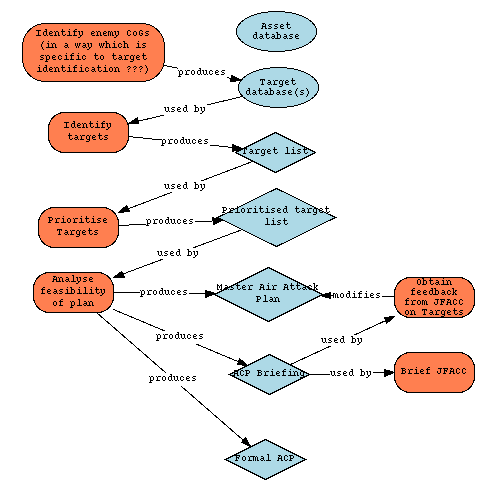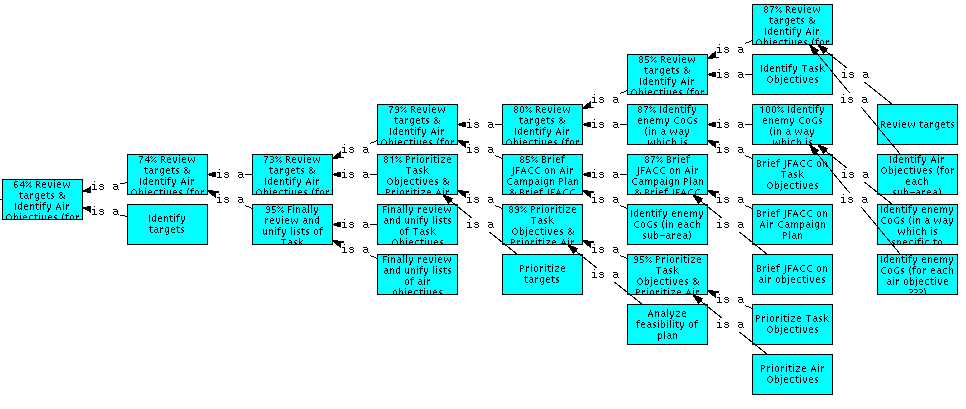Introduction to Air Campaign Planning
The knowledge acquisition effort which is described in this document focused on air campaign planning within a Joint Task Force (JTF). A JTF exists for one crisis (which usually implies one theater); however, there may be more than one JTF per theater. The JTF is under the control of the Joint Forces Commander (JFC).
The Joint Forces Air Component Commander (JFACC) is the functional commander responsible for the air operations within the overall campaign. The JFACC is appointed by the JFC, who usually selects the component commander contributing the greatest number of air assets to the JTF. The work of the JFACC and his staff is carried out in the Joint Air Operations Center (AOC).The JFACC reports to the JFC, who reports to the Commander in Chief (CinC) of the theater.
A Campaign Plan is a plan for all forces participating in a JTF and
typically covers a 6 month period. Each functional component within
the JTF will also have a specific campaign plan. The Air Campaign
Plan also covers a 6 month period. The overall plan is represented and
transformed into a Master Air Attack Plan (MAAP), from which the Air
Tasking Order (ATO), or battle plan, is produced. The ATO takes 36 hours to
produce and covers 24 hours. Mission Plans are derived
from the ATO; a mission plan constitutes the directions for a specific sortie.
Pilots then develop an Engagement Plan, which specifies the
maneuvers that will be used to execute the mission plan.
Once a crisis occurs, the CinC assesses the situation, selects a Course of
Action and may decide to establish a JTF. Then a warning order is
given, normally 3 days in advance of the commencement of operations.
Operations are initiated by a further order from the CinC, known as the
Operations Order.
When a crisis occurs and the CinC decides to take some action, the CinC
will provide planning guidance to the JFC. The guidance is
communicated to the component commanders (e.g. the JFACC) through the JFC.
The component commanders will in turn communicate the guidance to their
planners. Based on the guidance, the planning staff will take between 3 days
and 1 week to build a plan that may be executed.
Although the guidance (at every level) is considered to be an order rather
than a suggestion, negotiation does take place. If a commanding officer
proposes certain objectives or goals that are unreasonable, then participants
in the planning process have the responsibility for convincing the commanding
officer to take a different approach. For example, the planners may want more
time. But, to buy time in a crisis, something diplomatic has to be given
up. The commanding officer may not be willing to make a diplomatic sacrifice.
In some such situations, the commanding officer will enforce the initial
guidance; in other cases, the initial guidance may be relaxed.
However the Rules of Engagement (which are part of the initial guidance from
the CinC) are never negotiable.
Initial planning steps include assessing the situation and organizing the
planning staff. Assessing the situation involves identifying enemy centers
of gravity (COGs) [2]
and air defenses as well as determining a strategy and defining high level
objectives. A lot of knowledge about the theater is needed; typically the
planning staff has been studying the theater for years. The types of
information they know are whether the enemy has nuclear weapons, the nature
of the crisis, and the history of the conflict. The planning staff have, and
use, many maps with different perspectives of the theater.
When the planners cannot find required details,
they will rely on contacts with people who have the information or can get
the information. Typically these are intelligence people on the planning team.
It's often impossible to prove the accuracy of intelligence data,
because INTEL (the intelligence group) must protect their sources; however,
duplication of INTEL effort between different branches, which is encouraged,
may corroborate information or provide additional information.
If the planners cannot obtain the required information in time (it can take 3
days for information to arrive),
they will make assumptions and move to the next step.
Throughout the planning process, air planners are searching for alternatives,
vulnerabilities, consequences and contingencies.
The heart of the planning process consists of three stages:
The planning team usually consists of 8 people working 8-hour shifts (12 hours
in a crisis), which is only sufficient
to plan for one situation (the most likely case) and look very
hard at one other alternative (probably the worst case).
The planning staff hold 4-hourly meetings to discuss progress, obtain a
consensus of opinion, and to make sure that there is a smooth
transition between phases. The latter is very important, since it is
imperative that friendly forces are not
perceived by the enemy as being indecisive.
It's important to note that the planning process does not always continue
until each stage is fully completed. Often, the planning staff may only be
75\% finished with some activities when it is time to move on to the next
stage. This is usually due to resource constraints (insufficient staff to
perform more detailed analysis), although there is also a temporal constraint;
the dynamic environment in which planning takes place means that the situation
may have changed by the time thorough planning is completed.
In most cases, the JFACC will not want to be involved in the planning
process except for a daily briefing to make sure that guidance has
been communicated correctly.
This lack of involvement from the JFACC is deliberate and is designed
to foster openness and innovation. The air planning team does not normally
communicate with other branches
either, in order to enhance creativity, and to reduce the constraints of
reconciling too many points of view.
The modelling technique used to model the ACP process was based on the
CommonKADS methodology for knowledge modelling.
CommonKADS Wielinga92c Breuker94 is a collection of structured
methods for building knowledge based systems, analogous to methods such as
SSADM for software engineering. It was developed between 1983 and
1994 with funds from the European Community's ESPRIT program.
CommonKADS views the development of a knowledge based system as a
modelling activity, and so the heart of the method is the construction of
a number of models which represent different views on problem solving
behavior. Knowledge engineers are encouraged to construct some or all of the
following models:
Each of these models consists of one or more diagrams, showing different
perspectives on the knowledge contained within that model. For example,
one perspective
might model the activities which take place in an organization, while a
different perspective may represent the structure of that organization.
Each perspective therefore represents all acquired knowledge of a particular
type. The strength of this ``individual perspective'' approach appears when
the knowledge engineer tries to make the knowledge contained in the different
perspectives consistent; the presence of certain knowledge or data in one
perspective frequently highlights missing knowledge in another perspective.
This document provides CommonKADS models for the Air Campaign Planning process
and its surrounding environment. The models which are included are:
The stated aim of modelling the Air Campaign Planning (ACP) process was to
perform a ``task
analysis'' of the ACP process. However, after initial knowledge acquisition,
it was felt that there was considerable benefit to be gained from producing an
Organizational Model, showing the organization which surrounds ACP, before
analyzing the activities performed during the ACP process in detail. The
organizational model contains information on the activities, [4] the {\em
agents} and the resources which are used in the air campaign planning
process, as specified in Figure richmodel; each perspective is
represented by a single diagram, or by text.[5]
The organizational model also
contains ``cross products'' of these three different perspectives (again, see
Figure richmodel), which sometimes provide
the most useful information. For example, the CommonKADS Organizational Model
was used to model a Social Security department; a cross-product of activities
and structure was produced which highlighted an area of inefficiency, because
one of the activities (archiving) was being performed by three different
divisions of the department deHoog93.
The Dictionary perspectives are simply sets of activities (or agents or
resources) which are used as a basis for building the other perspectives. The
Network perspectives show how entities of the same type relate to one
another:
The Cross Product perspectives show how resources are produced, used,
consumed or modified within the process (Assets perspective), what
rights
agents have to resources (Rights perspective), and the obligations and
responsibilities to perform activities and to create states of affairs (
Responsibilities perspective).
Figure proctop shows the activities which represent the overall workflow
of Air Campaign Planning, and also shows how these activities link to form
processes.
Key: Plan Components
Preparation for planning
[2]
COGs are described in more detail in section Centers of Gravity.
Planning
The planning may be subdivided according to different phases of the conflict,
or possibly on other dimensions (e.g. geographical area).
[3]
The terms ``task objective'' or ``Course of Action'' may be used by some to
refer to air tasks
Introduction to the modelling technique used
Organizational Model of the ACP process
Introduction
[4]
CommonKADS actually calls these ``functions'' rather than ``activities''; at
lower levels of detail, the term ``tasks'' is used instead.
However, for reasons which are explained in Uschold95, I have chosen to
use
the term ``activities'' throughout this document.
[5]
This organizational model is a variation of the model proposed by CommonKADS.
The reasons for this variation are discussed in appendix
CommonKADSAppendix

Process Perspective
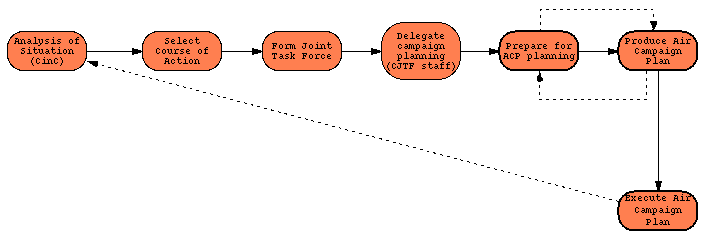

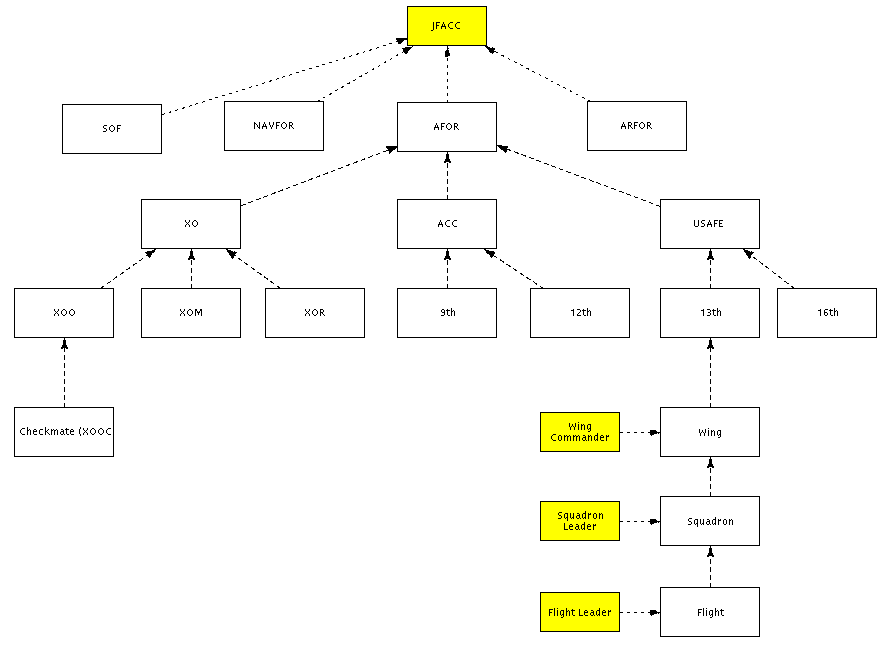
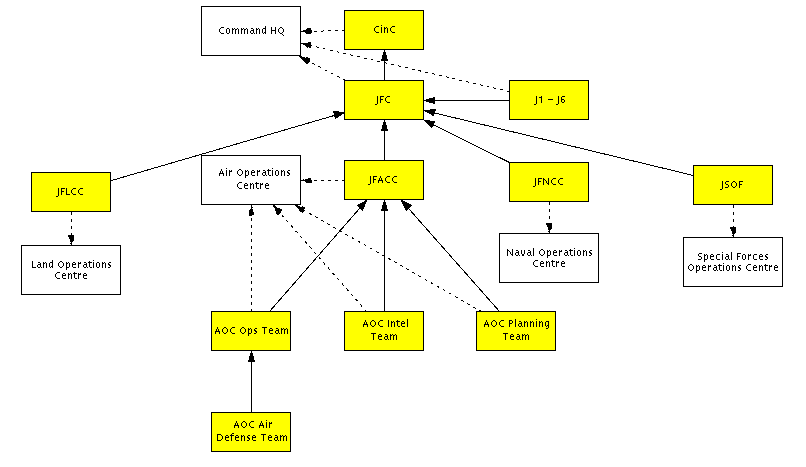
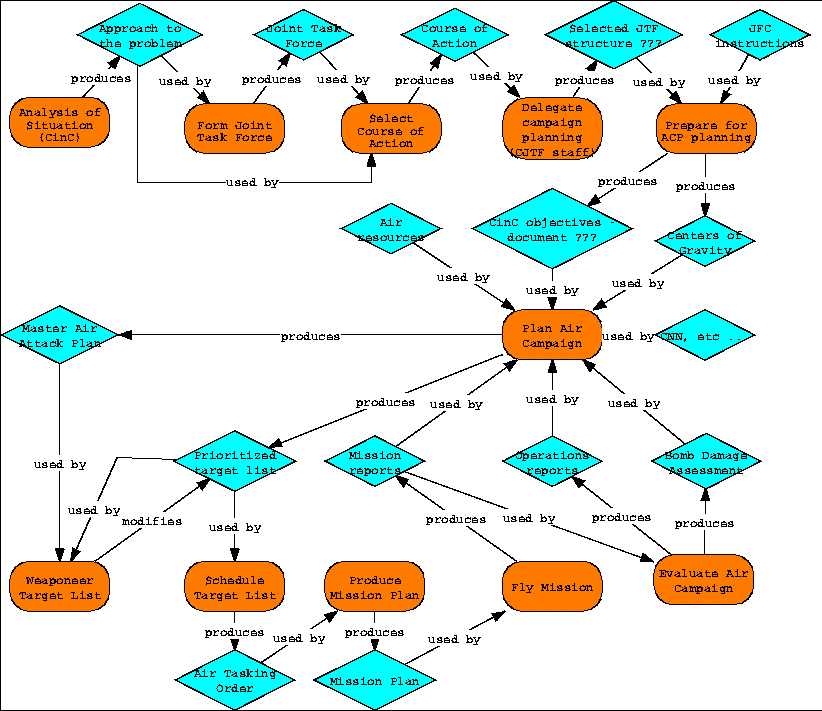
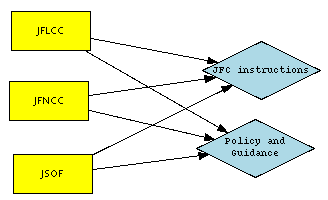
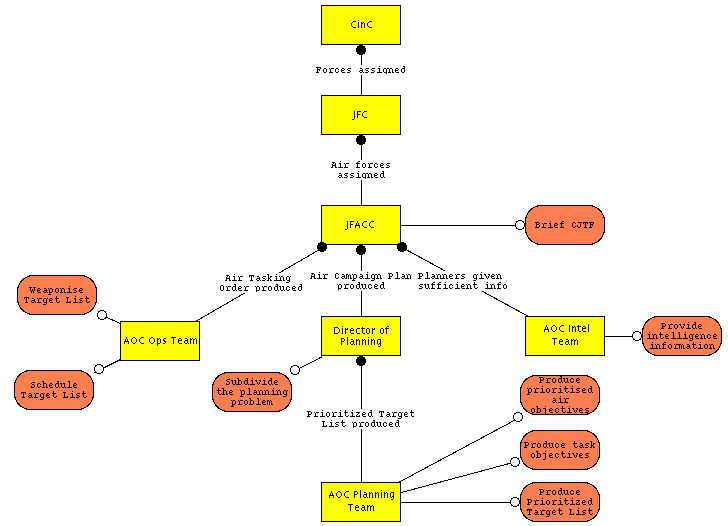
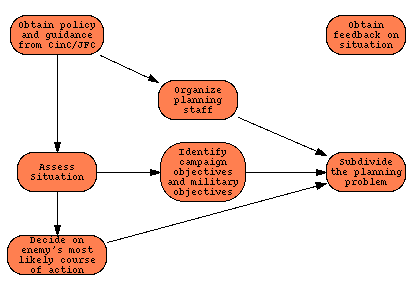 Key:
Key: 